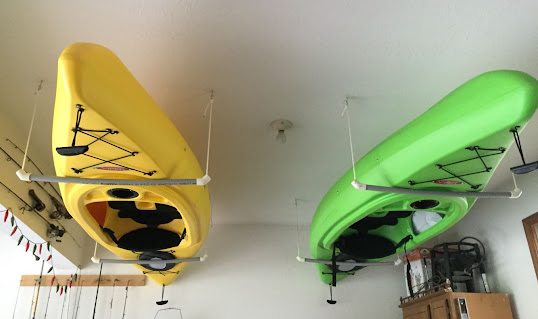How to safely store a kayak?
Autumn and winter are times when a large number of us will go on kayaking trips less and less often. Those who have made their own kayak must take care of this.
Where and
how to keep your kayak during the winter? How do you store it properly so it
doesn't get damaged?
Drain the remaining water in the kayak
We should
always store kayaks completely dry. If there is any residual water left in the
cockpit or compartments then damage to the kayak can occur during storage due
to freezing and thawing. This is especially important if you store the kayak in
an unheated area.
The exact
method of draining the kayak of water depends on the type of equipment you
have. For ordinary kayaks, where you sit inside, most of the water from the
cockpit and compartments should be pumped out using a bilge pump or removed
with a sponge.
Repair any damage
After the
end of the season of use, carefully inspect the surface of the kayak for damage
during rafting. All possible damage should be repaired even before storing the
kayak.
If there
are cracks or cavities in the plating, you may not do without reaching for the
help of specialists, especially in the case of polyethylene kayaks.
We also recommend reading the article How To Transport A Kayak In A Truck.
Clean the kayak thoroughly
Before
storage, the kayak should also be very thoroughly cleaned of all dirt. The best
way to do this is to use warm water mixed with a little liquid, such as soap,
and scrub it inside and out with a sponge or brush. After washing the canoe,
you need to rinse it thoroughly, wipe it with a dry cloth or towel and let it
dry completely.
The right place to store a kayak
When we own
a kayak we need to find a place to store it. Due to the dimensions of kayaks,
this is not so easy. The most popular touring kayaks are about 3.5 - 5 meters
long, so an apartment in a block of apartments is unlikely to be suitable for
this. It is also not advisable to store the kayak outside. Variable weather
conditions in autumn and winter, falling snow and rain, and low temperatures can
lead to damage to the kayak.
The best
solution seems to be a garage or other utility room with adequate space and
interior conditions.
If we don't
have a suitable garage or other space to safely store a kayak, we can consider
using self-storage facilities.
In what conditions to store a kayak?
The room
where we will store the kayak should be large enough for the kayak to fit in
without any problems, and at the same time not interfere with the normal use of
the place.
Make sure that the place where the kayak is stored is dry and away from heat sources - heating devices or brightly lit windows. Excessive heat causes kayaks to sag during storage, and the sun's UV rays can cause the kayak to fade. It is best to ensure that the room is at a constant temperature and humidity.
The kayak
should also not be exposed to chemicals, solvents, or other substances that can
damage it.
It will be interesting to know Kayaking is a Great Workout and Here's Why.
How to store a kayak?
Special
portable racks, as well as brackets and various types of wall-mounted hangers, can be purchased in sports or travel equipment stores to help us store our
kayak.
A portable
rack is easy to set up, does not require mounting hardware, and can be temporarily
moved outside, for example, but takes up a lot of floor space.
Holders and
hangers attached to the walls will allow you to effectively use the space that
is not used on a daily basis. With their help, the kayak can be
"attached" not only to the walls - horizontally and vertically - but
also suspended from the ceiling. The suspended system will work well for high
rooms or garages.
The mounts
are attached to the wall or ceiling with screws and bolts, which are included
in the set. Each time, we need to make sure that they are well seated, so that
the kayak does not slip on us, fall on someone's head, damage the car and other
equipment stored in the room, and is not damaged itself.
When
placing the kayak on any suspension, also pay attention to ensure that its
weight is distributed evenly. This will prevent the hull from deforming.

Comments
Post a Comment